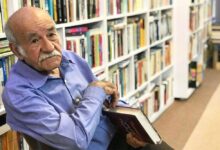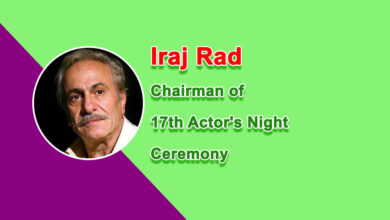A reflection on contemporary Armenian theater in Iran
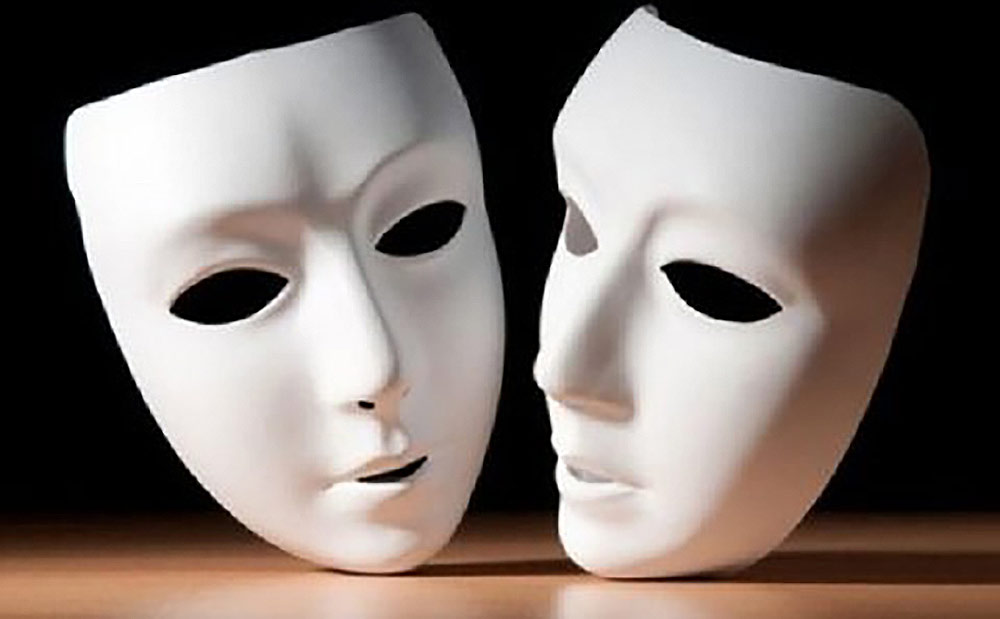
Alireza (Kavian) Hail Moghaddam* – With the happy beginning of 2023 and the blessed birth of the messenger of peace and kindness, Jesus Christ, to all the Christians of the world, especially the honorable Christian Iranians, we did not find it inappropriate to use this excuse, among the related news, reports and interviews With the events of Armenian theater groups in Iran, let’s have a look at the state of Armenian theater art in Iran.
In the report of October 8, 2022, the public relations of The General Department of Performing Arts of Ministry of Culture and Islamic Guidance, from the ceremony commemorating the 40th day of the death of the late Armenian artist from Maragheh, the late Leoni Tashchian(1926-2022), a veteran of Iranian theater, painting and design, at the museum Archbishop Ardak Manoukian(St. Mary’s Church), or the Armenian Anthropology Museum, available on the portal of this ministry, quoted by Serjik Margharian (the speaker of the ceremony), it is mentioned that this lady artist, in 2001, due to her many services in the field Art and participation in the establishment of Sipan cultural and sports complex(60 years old), which welcomes more than 200 Armenian artists and job seekers in the fields of theater, song, painting, puppet making, Armenian cultural fields and sports, from the said ministry. As one of the influential women in the field of art, she was recognized and honored.
Some of the participants in this ceremony were: Kazem Nazari (General Director of Performing Arts), Sergey Grigorian (Cultural Coordinator of the Armenian Embassy in Tehran), Hassan Ravandeh (Provincial Affairs Officer of the General Department of Performing Arts), Grigor Ghazarian (Translator and Art Researcher), Ahmad Joulaei (art researcher), Tehran Armenian Board of Trustees, Alice Shahmoradian (Director of Ardak Manoukian Museum) and Armenian and non-Armenian artists and researchers. Also, the documentary about the deceased’s portraitof her, directed by Ahmad Joulaei, was screened for the attendees. And while reviewing the biography of this outstanding figure of the Armenian theater, the educational role of Mkrtich Tashjian – Մկրտիչ Թաշճյան(late artist’s father), who himself was a theater artist, was discussed in three languages: Armenian, Persian and Turkish.
In this report, according to the statements of the Director General of the Department of Performing Arts, the Ministry promised to support Armenian theater groups in the main theaters of Iran, as well as the promise to send these groups to this country, with the agreement made with the cultural advisor of the Republic of Armenia Embassy, and the mutual hosting of the artistic groups of this northern neighbor of Iran, in the theater arena:
Andranik Khachumian(1955), translator, director, actor, writer, playwright, producer and producer of the pioneer cinema and theater of the country, during an interview with the website Artonline, has provided the readers with a deeper understanding of the state of Armenian performing arts and Armenian dramatic texts in Iran. Is. This member of the Association of Children and Adolescent Writers and the winner of the Kantag award in 2016 (an award given to the best translators of the year by the Armenian Writers’ Association in collaboration with the Holy Etchmiadzin Cathedral Church), in response to the question why Middle Eastern literature both in these countries and at the level Referring to his radio interview, Mayor Mehjoor Mande states: Introducing Armenian and Middle Eastern texts requires government investment. Armenian translators, if supported, can introduce Iranian customs to the Armenian people, but unfortunately they are not supported/ the government should find several Persian translators in different parts of the world to translate Persian books into different languages, and all these works require capital and without Government support cannot be used.
This four-term member of the Board of Directors of the Iranian Playwrights Association at Khaneh Teatar, with more than 36 book titles translated from Armenian to Persian during 20 years, in his rich cultural record, elsewhere in this conversation, in response to the question that your membership In the dramatists’ guild, how effective was it in introducing your plays, he says: It has no effect and I only send my printed texts to my friends in Telegram channels! In another part of his speech, he also points out the need for the help of the media to introduce the works of actors who are active in translation and authoring of plays, both Iranian and Armenian, and emphasizes that: you can’t count on translation income, unless these plays are performed somewhere to give copyright to the creator of the works.
Mr. Khachumian, in response to what other people do you know in the field of translation of Armenian dramatic literature? He says: Unfortunately, apart from my brother Vahik, who has translated two books from Armenian to Persian, we have no one else in the field of translating plays. Of course, the situation is better in the case of novels and poetry. It should be mentioned that Hamon and Darya, written by Abbas Jahangiriyan, Chinese wife, written by Rahmat Amini and two plays by Ismail Shafiei, are among his Persian to Armenian translations.
In the 58th issue of Peyman Cultural Quarterly (year 15, winter 2011), in an article written by Vartan Davodian, who describes the history of the establishment and formation of the Ararat Cultural and Sports Club, on the eve of its 70th anniversary, we read about the theatrical activities of the Armenian members of this club:
Ararat cultural and sports club was established in Tehran on July 4, 1944, with the efforts of 122 Armenian youth (founding members). In the communal conditions of that time, staging and performing folk music, classical music recitals and concerts, choir performances, performing moral plays and various cultural and literary programs, in maintaining and strengthening the spirit of the society, which was affected by the political events after the war, it was very effective… All the activities of the club are carried out in two separate centers, which are: 1- The center of artistic activities located on Jomohri-e-Islami Street, Nobahar Alley, 2- Ararat Stadium in Vanak area. Until 1953, when the club rented and then bought the central building located on Naderi Street (now Islamic Republic), it continued to work by renting rooms on Hafez and Qawam Al-Saltaneh Streets (Now 30 Tir). From 1953 until the publication of this article (2011), this center has been the center of artistic activities and has a performance hall called Komitas, for holding cultural-artistic programs with a capacity of 440 spectators, and a small hall called Hakop Karapentes, library, document archive and administrative department. Is.
The following timeline, written by Gilbert Meshkenbryans, in issue 38 of Peyman Quarterly (10th year, winter 2006), beautifully explains the presence of Iranian Armenians in the field of theater:
– 1879: The performance of the first performance of the Armenians of Tabriz in Gholeh neighborhood, by the efforts of Rev. Masrop Papazian (director of the Armenian school of Tabriz)
– 1881: The establishment of the first Armenian theater group in Tehran, with performances in homes, from this year until 1883. Hosep Tadeosyan with two plays Avesta Petros and Shoshanik and two dramas. He was among those who performed in his home during these years.
– 1884: The construction of the great hall of the Armenian school, located at the Qazvin gate of Tehran, and the flourishing of performing arts among the Armenians of Tehran.
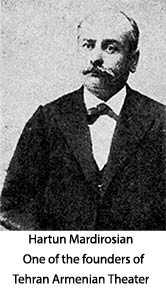
– 1888: Establishment of the Tehran Theater Lovers Association, with the efforts of Hartun Mardirosyan, who also took over as the chairman of its board of directors.
– 1886: Establishment of the first Armenian theater group of Isfahan, with the performance of: Anjir Chekho, under the auspices of Bagler Aghayan, in a house belonging to Vank Church.
– 1890: Prohibition of theatrical activities of all Armenian groups in Isfahan, by the order of Bishop Yesai Asdewazadorian (the Caliph of the Armenians at the time) for 7 years.
– 1899: Establishment of the Association of Theater Lovers in Isfahan and the approval of Jathliq Mkrtich Khrimian – Մկրտիչ Խրիմեան, with the role played by women if it does not conflict with the Sharia, in response to the appeal of the Bishop of Jolfa of Isfahan, Makakia Daronian and performed by: Bebo, Eger Gabriel Sondoukian, the first play performed With the presence of women on the scene, after this date
– 1900: The establishment of the Theater Lovers Association in two large Armenian neighborhoods of Tabriz
– 1904: Construction of a hall and theater in the city of Khoy, West Azerbaijan
– 1909: The formation of the group of theater lovers, consisting of Armenian and non-Armenian residents of Tabriz, to perform plays in Persian language.
– 1910: Performance of a show with the presence of Armenian and Caucasian artists such as Abelian, Armenian, Manuelian, Siranush, etc. in Tehran
– 1913: commemoration of the 25th anniversary of the establishment of the theater group in the Jolfa neighborhood of Isfahan and the development of relations between Caucasian artists in this Armenian neighborhood
– 1914-1915: The construction of a five-hundred-seat Aramian theater hall in the Armenian ghalleh neighborhood of Tabriz, with about three decades of activity.
– 1916 onwards: Invitation to non-Armenian theater groups to use the Aramian Hall (some of the artists who played an important role in the formation of the Iranian Armenian theater in these years were, for example: Aramais Aghamalian, Yeprad Baruyan, Yelena Audisian, Megdich Tashchian and … were from Azerbaijan, Iran and Manuel Marutyan, from Yerevan. In the same year, the artist couple (Varto and Arto Tarian), who had started their official career two years before, appeared on the stage of Tehran. Dramatic Studio, where Arto She managed it, in the 20s, she had a special place among the young people of Tehran. Apparently, by directing the show Threat, Varto can be called the first female theater director in Iran.
– 1930: Formation of the drama group of the Armenian Actors’ Association in Jolfa, Isfahan, and the performance of plays such as: The War of the Maliks, Kaj Nazar, Lili and Majnoon, Names, Shirin and Farhad, and Sayat Nova with artists Grigoris Nazlumian, Armen Magerdomian, Tigran Abgarian and… (Performance of sixteen plays along with Anoush’s opera for the first time this year in Isfahan).
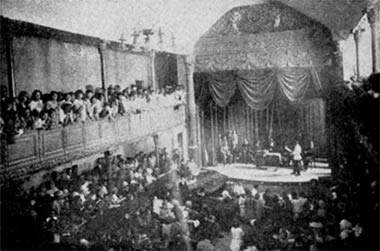
– 1935: Megdich Tashchian’s presence in Jolfa and restoration of the Armenian Central School hall for performances with the cooperation of Aros Tashchian, Artosh Minassian and others.
– 1946: The performance of the wedding plays of Kodkhoda Ahmad, Arshin Malalan, Blood price of Iran, for Persian speakers by Armen Magerdomian. Also, in this year and the year before, performances for children and teenagers were noticed, and groups such as the children’s theater group headed by R. Atayan and N. Aghasian or the children’s palace theater, headed by Sarwarian, started producing shows for This age group in the Armenian community.
Currently, trying to obtain classified information such as: Christian theater organizations in the country (for example, Armenian theater groups registered in the registration system of the Ministry of Guidance or other data banks), does not lead to valuable information. Through the independent Armenian artists in Iran, with the efforts of the Armenian Caliphate Council of Tehran, a few of them were contacted before preparing this report in order to have a conversation with informed people (especially in the body of Armenian theater with a strong background in performing arts and influence). provide an undeniable history of Iranian theater during the last two centuries), Unfortunately, it did not work!

It seems that today’s Christian artist compatriots need a more committed and organized participation to revive the brilliant era of their theater and Iran, as it was mentioned decades ago. Those who rightly, have a lot of right on the shoulders of Iranian theater and its development over the past 150 years.
* Senior theater expert – writer, translator, playwright, voice actor and performing arts researcher


